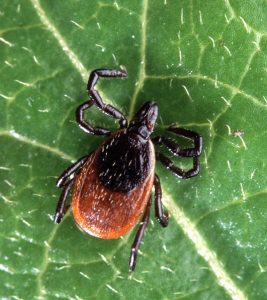May 10, 2018
Ticks, Ticks and more Ticks!
Since even last year, the threat of ticks and Lyme disease is believed to be even greater. As a reminder, re are repeating our guest blog written last summer by Dr. Shelley Hutchings, the OHS’s Chief Veterinarian.

Ticks, Ticks and more Ticks!
Ticks are generating lots of conversation around Ottawa. This is thanks to our veterinary community and local public health authorities who are working hard to heighten awareness on ticks and the health risks that they pose to us and our pets.
The Black-Legged tick that carries the bacteria that can cause Lyme disease has been found in the Ottawa area, and therefore Ottawa has now been declared an at-risk area for Lyme disease.
Ottawa Public Health has reported that more than 20 per cent of ticks tested from this area last year were positive for Borrelia burgdorferi, the bacteria responsible for Lyme disease!
Lyme disease, can cause potentially life threatening illness in dogs, and precautions should be taken to help prevent infection of our four-legged canine friends.
The most important thing you can do is to prevent Lyme disease before it happens. Here are some tips on dealing with ticks in your pet:
Finding a tick
Whenever your pet goes into grassy and wooded areas, even in the city, they could pick up a tick. When you return from a walk, be sure to survey your pet for ticks, especially in areas where there is less hair, such as armpits and thighs.
Ticks can be of various sizes depending on their age and species, so it may not be obvious when a tick initially attaches to the skin. Once a tick starts feeding, it will grow in size and will become more noticeable. If you feel a small hairless bump that you have not noticed before, this could be a tick. If you look closely at the attachment site, you may be able to see the eight legs and brown head.
Removing a tick
Correct removal of the tick involves removing the entire tick. The tick has embedded its head into your pet’s skin so it important to remove it properly.
Tweezer method
Using a pair of sharp tweezers, grab the tick as close to the skin as possible, and pull straight out from the skin. Once you have removed the tick, check to ensure that the head is attached to the tick and not in the skin.
Tick removal tool
To use a tick removal tool, slide the prongs over the tick so the head is between the prongs. Gently twist the tool around in a circle and gently pull up. Some tools have slightly different designs, so refer to the instructions provided with the tool.
Do not:
Attempt to force the tick to release by burning it with a flame, a chemical or puncturing its body.
Grab the end of the tick’s body and pull.
We don’t recommend these methods because the tick can ‘vomit’ into the skin and/or the head can be detached and left in the skin, both of which can cause skin infections.
Preserving and killing the tick
Once the entire tick is removed, place it in a leak-proof container of rubbing alcohol. You may want to have the tick and discuss with your veterinarian if any further tests need to be run on the tick.
Cleaning the bite site
After you have removed the tick, clean the bite site with antibacterial soap and water. Monitor the site over the next week for any redness or swelling that may suggest an infection.
Avoiding tick bites
There are multiple veterinary products that you can give to your pet that will help prevent tick bites. Ask your veterinarian what options are best for you and your pet.
Dr. Shelley Hutchings
OHS Chief Veterinarian
